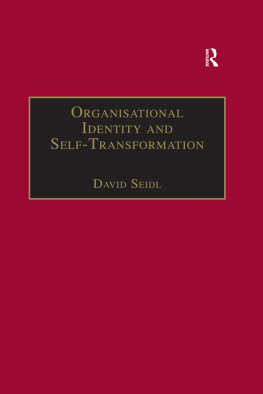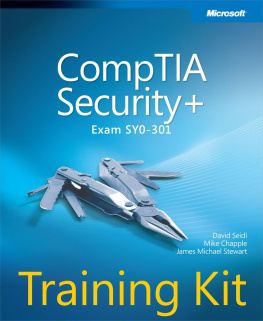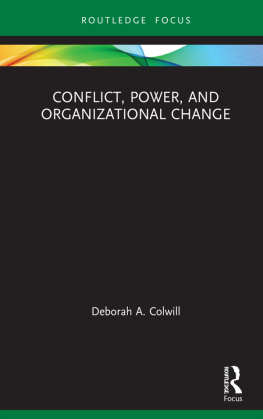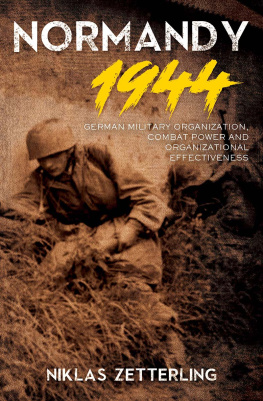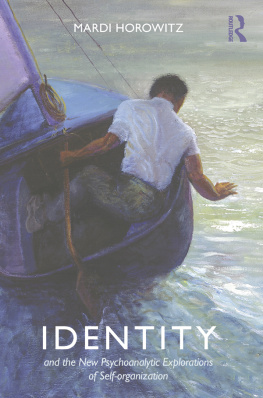First published 2005 by Ashgate Publishing
Published 2016 by Routledge
2 Park Square, Milton Park, Abingdon, Oxon OX14 4RN
711 Third Avenue, New York, NY 10017, USA
Routledge is an imprint of the Taylor & Francis Group, an informa business
Copyright David Seidl 2005
All rights reserved. No part of this book may be reprinted or reproduced or utilised in any form or by any electronic, mechanical, or other means, now known or hereafter invented, including photocopying and recording, or in any information storage or retrieval system, without permission in writing from the publishers.
Notice:
Product or corporate names may be trademarks or registered trademarks, and are used only for identification and explanation without intent to infringe.
David Seidl has asserted his right under the Copyright, Designs and Patents Ai 1988, to be identified as the author of this work.
British Library Cataloguing in Publication Data
Organisational identity and self-tranformation : an
autopoietic perspective
1. Group identity 2. Identity (Psychology) 3. Organisational
sociology 4. Social structure 5. Autopoiesis
I. Title
302.4
Library of Congress Control Number: 2005929780
ISBN 9780754644583 (hbk)

Humanity mirrors and reproduces itself through the work of its systems. We may normally think of the systems through which we live and work as providers of structures that direct our thinking and actions or as producers of products that satisfy our needs and cater to our interests, but they perform another, and perhaps more radical, human service: they create and recreate the forms and appearances that constitute the immediate reality of our world. Without the constant work of reproduction and repetition by our systems, the human world would dissolve and disappear and so would its human habitants since we can only know and maintain ourselves as reflections of the objects and structures that serve as props for our daily living. The supermarket has to refill its empty shelves each night in order to ensure its continuation the following day, the newspaper must reassemble the news of the world on a daily basis in order to ensure its repeated publication, and the television station must animate the television screen with the continuous presentation of audio-visual images. The empty supermarket, the newspaper that does not appear, the lifeless television screen simply illustrate the existential shock that would accompany the disappearance of the constitutive forms and meanings of the human world.
The constant work of human systems is thus radically focussed on saving the appearances of the human world. In this interpretation, the objects that support us in the daily work of living are not just instrumental tools to facilitate the tasks of existence or to extend our powers. They are also, and perhaps more significantly, the means for mirroring the human image through projections and extensions of itself into the environment. In this way, the human system talks back to its users to assure them that they are living in a human world. In saving the appearances, the system also saves its human users and reminds them that they are habitants of a human world. A basic strategy in saving human appearances is the fitting together of the human body and its environment so that the human organs and senses, like the pieces of a jigsaw puzzle, can conveniently fit the various spaces into which the body projects itself: the chair is made to accommodate the shape of the body and its tiredness, the book can be held in the hand and within range of the eyes, the telephone connects directly with the ear. Such examples underline the significance of the immediate and continuous presence of the specific contents of the human world as well as their presentability and hence their ready readability. Body and environment are thus organically intertwined. When this organic intertwining breaks down, the meaningful objects and structures of the world dissolve and disappear. Seen from this perspective, human systems are structured connections or organisations of bodily organs and senses with the supportive objects of their environments. Organisations thus can be meaningfully understood as extensions of human organs and senses. This is an old idea which has been lost in the modern stress on organisations as instrumental systems. We see it in the medieval idea of the community as corporation which directly reflected the idea of the social body as a corpus or an articulated collection of organs and senses. In this radical sense, the human organisation is the work of the body and its organs and senses in constantly creating and recreating connections and correspondences between themselves and the environment. When these connections and correspondences break down, so does the organised world of human appearances.
David Seidls book can be read as a systematic and meticulous analysis of the work of human systems in the continuous work of saving the structures and appearances of the human world. His focus is on organisations as human systems and more especially on organisations as self-generating systems that maintain a sense of human continuity. The central term in Seidls analysis for this work of self-generation is autopoiesis or self-making. Autopoiesis a term which originated in theoretical biology refers to the making of the forms of life in general. Applied to human systems, it means the making of objects and structures that both mirror and reproduce the human world and its occupants. The making of the forms of life is an infinite and never-ending act of creation which exists for itself and not for some external reason. It has no goal or object beyond itself. It is simply the making of making and the forming of forming. All this means that autopoiesis is a fundamental force or power that generates itself. It has to be understood as a generic rather than a specific creative force. As the moving power of human systems and their perpetual regeneration, autopoiesis is less to do with the making of specific objects, of a particular x or y , and is much more about making as a fundamental life-force whose overall function is to repair, restore and redeem itself and thus save the human world from dissolution and disappearance. Viewed in this way, the work of the supermarket, the newspaper and the television station begins to assume an existential significance rather than a simply practical and instrumental meaning.
The institutions and organisations of the everyday world are now to be reinterpreted as expressions of an ultra-physical life-force rather than the products of rationally focussed human plans and intentions. The factory, the hospital, the school, the university and the department store may present exterior impressions of rational order and directed purpose but this pragmatic interpretation simply conceals their generic origin as human systems that repeatedly create and re-create the forms and meanings of the human world in order to save its existential appearances. This is what David Seidl means when he places autopoiesis in its social context through the work of the sociologist Niklas Luhmann. Luhmann reinterprets the original biological understanding of autopoiesis to reveal its social significance and adds to it insights from a diverse range of intellectual fields such as cybernetics and communication theory. Autopoiesis in its social context is the continuous pursuit of social forms and structures. For Luhmann, autopoiesis in the social context is not about the forms and structures themselves but about the forever unfinished work of reproducing and redeeming them as if the processes of reproduction and redemption were more important than their objectives. The forms and structures of social life are intrinsically unstable; they are momentary events that pass away as soon as they occur. Autopoiesis in the human world is the constant work of preserving some sense of stability and meaningfulness, however fictional, to this arbitrary flow of events. Luhmanns re-working of autopoiesis reminds us at times of Max Webers view of the world as a meaningless infinity on which we impose convenient fictions . For Luhmann, the human being is one such fictional product of social autopoiesis; the so-called self-consistency of the human being is a necessary but illusory product of the social system in its continuous attempts to save itself from dehiscence and dissipation.

